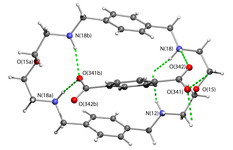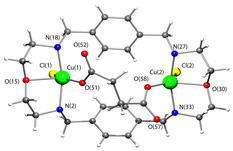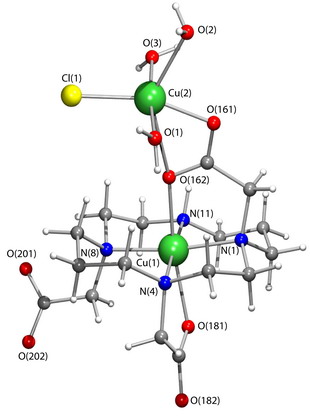Research Activities
Uptake of Anionic Substrates by Polyaza Macrocyclic Receptors
|
Polyaza macrocycles (or cryptands) of large cavity size are able to bind more than one metal ions and when protonated they form polyammonium architectures appropriate for the uptake of anions. The present project aims to design, synthesize and study new frameworks for the selective uptake of herbicides, pesticides and toxic dicarboxylates (such as phthalates). The new molecular architectures need to complement the envisaged anionic substrate. Pesticides and some dicarboxylates are important industrial chemicals and already widespread in our environment. There exists a need for their analytical determination and for techniques for their removal from water and soil. The selective recognition of a given anionic substrate by the synthetic organized polyammonium receptor, or by their dinuclear complexes, leads to the formation of stable supramolecular assemblies. Potential applications are sensors for the specific anion and devices for its removal from water. Hydrogen bonds, electrostatic interactions and other weaker interactions working cooperatively are mainly responsible for the behaviour of supramolecular compounds. |
||||
 |
 |
 |
||
Tailor-Made Macrocycles for Lanthanide Ions: Potencial Pharmaceuticals Drugs
|
The introduction of substituents with functional groups like acetate and phosphonate acids at the donor atoms of macrocycles ("pendant arms") can lead to compounds which show high stability constants for their lanthanide complexes with the simultaneous increase of their kinetic inertness towards dissociation. For some lanthanides like samarium and holmium, and group 3a elements like gallium and indium, radioactive isotopes (153Sm, 166Ho, 67Ga, 111In) with comparatively rapid decay are available. Complexes of the lanthanide isotopes are currently used in the detection and treatment of cancer, despite several disadvantages like toxicity and slow complex formation. We are presently preparing new macrocycles with deliberately located carboxylate and phosphonate groups in the pendant arms of the same molecule aiming to prepare lanthanide complexes with enhanced properties which could allow the reduction of the dosage of the radiopharmaceuticals and increase the lifetime of the patients. In addition, these functional groups are natural links for the attachment of biological molecules (e.g. small proteins) leading to bioconjugates with selectivity for receptor sites, allowing for the development of improved therapeutic radiopharmaceuticals. |
|




